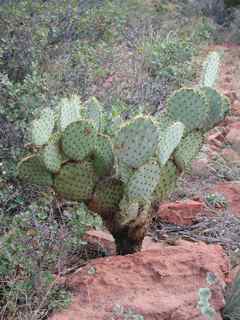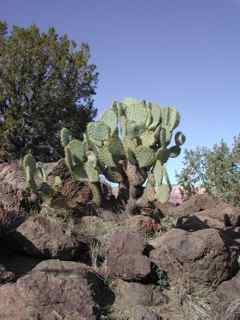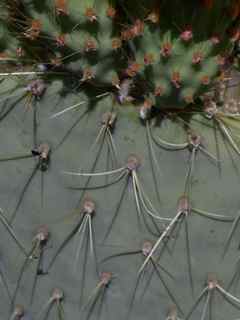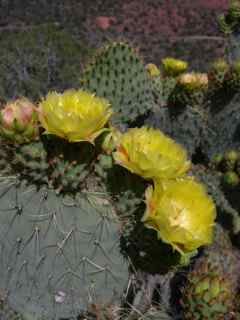|
|
 Plant - fall Max Licher @http://swbiodiversity.org, Usage Rights: Creative Commons Attribution-ShareAlike (CC BY-SA) |  Plant - fall Max Licher @http://swbiodiversity.org, Usage Rights: Creative Commons Attribution-ShareAlike (CC BY-SA) |  Spines Max Licher @http://swbiodiversity.org, Usage Rights: Creative Commons Attribution-ShareAlike (CC BY-SA) |  Flowers Max Licher @http://swbiodiversity.org, Usage Rights: Creative Commons Attribution-ShareAlike (CC BY-SA) | | |
|
Origin:
Native Similar Species: O. santa-rita (not in Yavapai County)
General Desc:
Erect, tree-like cactus, usually with a stout trunk and ascending branches consisting of nearly round pads.
Identification notes: Distinguished from other Opuntia sp. by its well defined trunk, the scarcity of spines where areoles are mostly dense patches of yellow glochids with few yellow, generally deflexed spines; and the mostly orbicular pads.
Height:
3 to 8 feet
Width:
Habitat Description: Found growing on very steep hillsides in mountainous terrain, also on mesas and dry, rocky desert walls.
Plant Communities:
Desert Scrub, Interior Chaparral, Semidesert Grasslands, Pinyon Juniper Woodland
Elevation: 2000 - 6000 feet
Color:
Yellow
Flowering Period:
May - Jun
Description:
Flowers are 2-1/2 to 2-3/4 inches in diameter with petals about 1 inch long and 1/2 inch wide.
Stem Color:
Yellow-green
Number of Stems:
Single
Stem Shape:
Pads
Stems Segmented:
Y
Stem Surface:
Smooth
Stem Description:
The pads of this prickly pear are almost perfectly round, 4 to 8 inches, giving rise to its common name.
(structures unique to cacti, found on the stems, areas from which spines, flowers and fruits emerge)
Areole Description:
Prominent areoles are 1/2 to 3/4 inch apart and contain a tuft of yellow wool, numerous yellow glochids and 3 to 7 spines, 1/2 to 1-1/2 inches long. On the main stem areoles contain 15 to 40 spines radiating from the center and covering the whole stem.
Spine Color:
Yellowish-brown
Spines Hooked:
N
Spine Description:
Mostly straight but can be weakly curved.
Glochids: Y (Glochids are minute barbed hairs or bristles)
Glochid Description: Crowded in narrow marginal crescent near the pad.
Fruit Color: Red
Fruit Notes: Fleshy, reddish-purple fruit, 1 to 2 inches long, is not spiny.
|
|